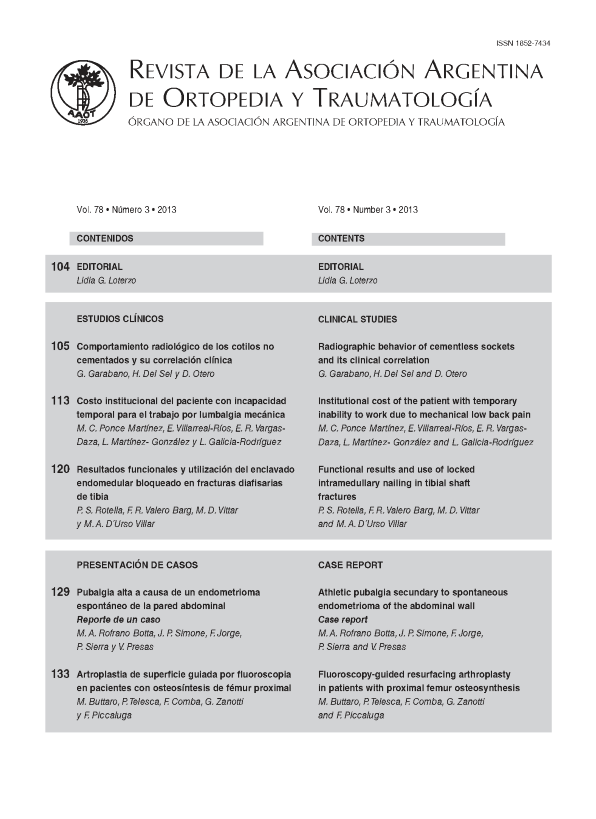Matriz para ingeniería de tejido óseo: modificación superficial con zinc. Estudio preliminar. [Scaffold for bone tissue engineering: superficial modification with zinc. Preliminary study]
Contenido principal del artículo
Resumen
Descargas
Métricas
Detalles del artículo

Esta obra está bajo licencia internacional Creative Commons Reconocimiento-NoComercial-CompartirIgual 4.0.
La aceptación del manuscrito por parte de la revista implica la no presentación simultánea a otras revistas u órganos editoriales. La RAAOT se encuentra bajo la licencia Creative Commons 4.0. Atribución-NoComercial-CompartirIgual (http://creativecommons.org/licenses/by-nc-sa/4.0/deed.es). Se puede compartir, copiar, distribuir, alterar, transformar, generar una obra derivada, ejecutar y comunicar públicamente la obra, siempre que: a) se cite la autoría y la fuente original de su publicación (revista, editorial y URL de la obra); b) no se usen para fines comerciales; c) se mantengan los mismos términos de la licencia.
En caso de que el manuscrito sea aprobado para su próxima publicación, los autores conservan los derechos de autor y cederán a la revista los derechos de la publicación, edición, reproducción, distribución, exhibición y comunicación a nivel nacional e internacional en las diferentes bases de datos, repositorios y portales.
Se deja constancia que el referido artículo es inédito y que no está en espera de impresión en alguna otra publicación nacional o extranjera.
Por la presente, acepta/n las modificaciones que sean necesarias, sugeridas en la revisión por los pares (referato), para adaptar el trabajo al estilo y modalidad de publicación de la Revista.
Citas
2. Liu C, Xia Z, Czernuszka JT. Design and development of three-dimensional scaffolds for tissue engineering. Chem Eng Research Design 2007;85:1051-64.
3. Dorozhkin SV. Bioceramics of calcium orthophosphates. Biomaterials 2010;31:1465-85.
4. Ronen A, Semiat R, Dosoretz CG. Antibacterial efficiency of a composite spacer containing zinc oxide nanoparticles. Proc Engineering 2012;44:581-2.
5. Wang T, Zhang J, Chen Y, Xiao P, Yang M. Effect of zinc ion on the osteogenic and adipogenic differentiation of mouse primary bone marrow stromal cells and the adipocytic trans-differentiation of mouse primary osteoblasts. J Trace Elem Med Biol 2007;21:84-91.
6. Hie M, Iitsuka N, Otsuka T, Nakanishi A, Tsukamoto I. Zinc deficiency decreases osteoblasts and osteoclasts associated with the reduced expression of Runx2 and RANK. Bone 2011;49:1152-9.
7. Yang L, Perez-Amodio S, Barrère-de Groot F, Everts V, Blitterswijk C, Habibovic P. The effects of inorganic additives to calcium phosphate on in vitro behavior of osteoblasts and osteoclasts. Biomaterials 2010;31:2976-89.
8. Peretz A, Papadopoulos T, Willems D, Hotimsky A, Michiels N, Siderova V, et al. Zinc supplementation increases bone alkaline
phosphatase in healthy men. J Trace Elem Med Biol 2001;15:175-8.
9. Ito A, Otsuka M, Kawamura H, Ikeuchi M, Ohgushi H, Sogo Y, Ichinose N. Zinc-containing tricalcium phosphate and related materials for promoting bone formation. Current Applied Physics 2005;5:402-6.
10. Storrie H, Stupp S. Cellular response to zinc-containing organoapatite: An in vitro study of proliferation, alkaline phosphatase
activity and biomineralization. Biomaterials 2005;26:5492-9.
11. Wanga X, Ito A, Sogo Y, Li X, Oyane A. Zinc-containing apatite layers on external fixation rods promoting cell activity. Acta Biomaterialia 2010;6:962-8.
12. Nagata M, Lönnerdal B. Role of zinc in cellular zinc trafficking and mineralization in a murine osteoblast-like cell line. J Nutr Biochem 2011;22:172-8.
13. Toledano M, Yamauti M, Ruiz-Requena ME, Osorio R. A ZnO-doped adhesive reduced collagen degradation favouring dentine remineralization. J Dent 2012;40:756-65.
Pawlig O, Trettin R. Synthesis and characterization of α-hopeite, Zn3 (PO4)2.4H2O. Materials Research Bulletin 1999;34:1959-66.
15. Chao GY. Refinement of the crystal structure of parahopeite. Zeits Krist 1969;130:261-6.
16. Anusavice KJ. Dental cements for bonding applications. En: Anusavice KJ, Phillips RW. Phillips’ Science of Dental Materials, 11a ed. Philadelphia: Saunders; 2003:565-7.
17. Gomes S, Nedelec JM, Renaudin G. On the effect of temperature on the insertion of zinc into hydroxyapatite. Acta Biomater 2012;35:1180-9.
18. Mayer I, Featherstone JD. Dissolution studies of Zn-containing carbonated hydroxyapatites. J Crystal Growth 2000;219:98-101.
19. Ito A, Ojima K, Naito H, Ichinose N, Tateisshi N. Preparation, solubility, and cytocompatibility of zinc-releasing calcium phosphate ceramics. J Biomed Mater Res 2000;50:178-83.
20. Bandyopadhyay A, Withey EA, Moore J, Susmita B. Influence of ZnO doping in calcium phosphate ceramics. Materials Science and Engineering 2007;27:14-17.

